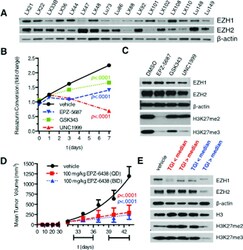Antibody data
- Antibody Data
- Antigen structure
- References [2]
- Comments [0]
- Validations
- Other assay [1]
Submit
Validation data
Reference
Comment
Report error
- Product number
- PA1-41114 - Provider product page

- Provider
- Invitrogen Antibodies
- Product name
- EZH1 Polyclonal Antibody
- Antibody type
- Polyclonal
- Antigen
- Other
- Description
- This antibody is 86% homologous to rat and canine. Suggested positive control: antigen standard for EZH1 (transient overexpression lysate), human or mouse spleen.
- Reactivity
- Human, Mouse
- Host
- Rabbit
- Isotype
- IgG
- Vial size
- 100 μg
- Concentration
- 1 mg/mL
- Storage
- Store at 4°C short term. For long term storage, store at -20°C, avoiding freeze/thaw cycles.
Submitted references EED-Targeted PROTACs Degrade EED, EZH2, and SUZ12 in the PRC2 Complex.
DNA methylation in small cell lung cancer defines distinct disease subtypes and correlates with high expression of EZH2.
Hsu JH, Rasmusson T, Robinson J, Pachl F, Read J, Kawatkar S, O' Donovan DH, Bagal S, Code E, Rawlins P, Argyrou A, Tomlinson R, Gao N, Zhu X, Chiarparin E, Jacques K, Shen M, Woods H, Bednarski E, Wilson DM, Drew L, Castaldi MP, Fawell S, Bloecher A
Cell chemical biology 2020 Jan 16;27(1):41-46.e17
Cell chemical biology 2020 Jan 16;27(1):41-46.e17
DNA methylation in small cell lung cancer defines distinct disease subtypes and correlates with high expression of EZH2.
Poirier JT, Gardner EE, Connis N, Moreira AL, de Stanchina E, Hann CL, Rudin CM
Oncogene 2015 Nov 26;34(48):5869-78
Oncogene 2015 Nov 26;34(48):5869-78
No comments: Submit comment
Supportive validation
- Submitted by
- Invitrogen Antibodies (provider)
- Main image

- Experimental details
- Figure 7 Pharmacologic inhibition of EZH2 in SCLC inhibits growth in vitro and in vivo A) EZH1 and EZH2 are consistently expressed in a panel of SCLC PDXs as measured by Western blot B) Ex vivo growth of the SCLC PDX LX92 is significantly inhibited by the EZH2 inhibitors EPZ-5687, GSK343, and UNC1999 as measured by resazurin conversion (2-way ANOVA, adjusted for multiple comparisons by the method of Dunnet) C) Western blot analysis of day 7 lysates from LX92 lysates treated with various EZH2 inhibitors. D) In vivo growth of the SCLC PDX LX92 is significantly inhibited by the EZH2 inhibitor EPZ-6438. E) Western blot analysis of endpoint LX92 tumor lysates treated with various EPZ-6438 treatment schedules. Tumors with growth inhibition greater than the median (TGI>median) for each treatment group were pooled separately from those with less robust response (TGI
 Explore
Explore Validate
Validate Learn
Learn Western blot
Western blot Other assay
Other assay